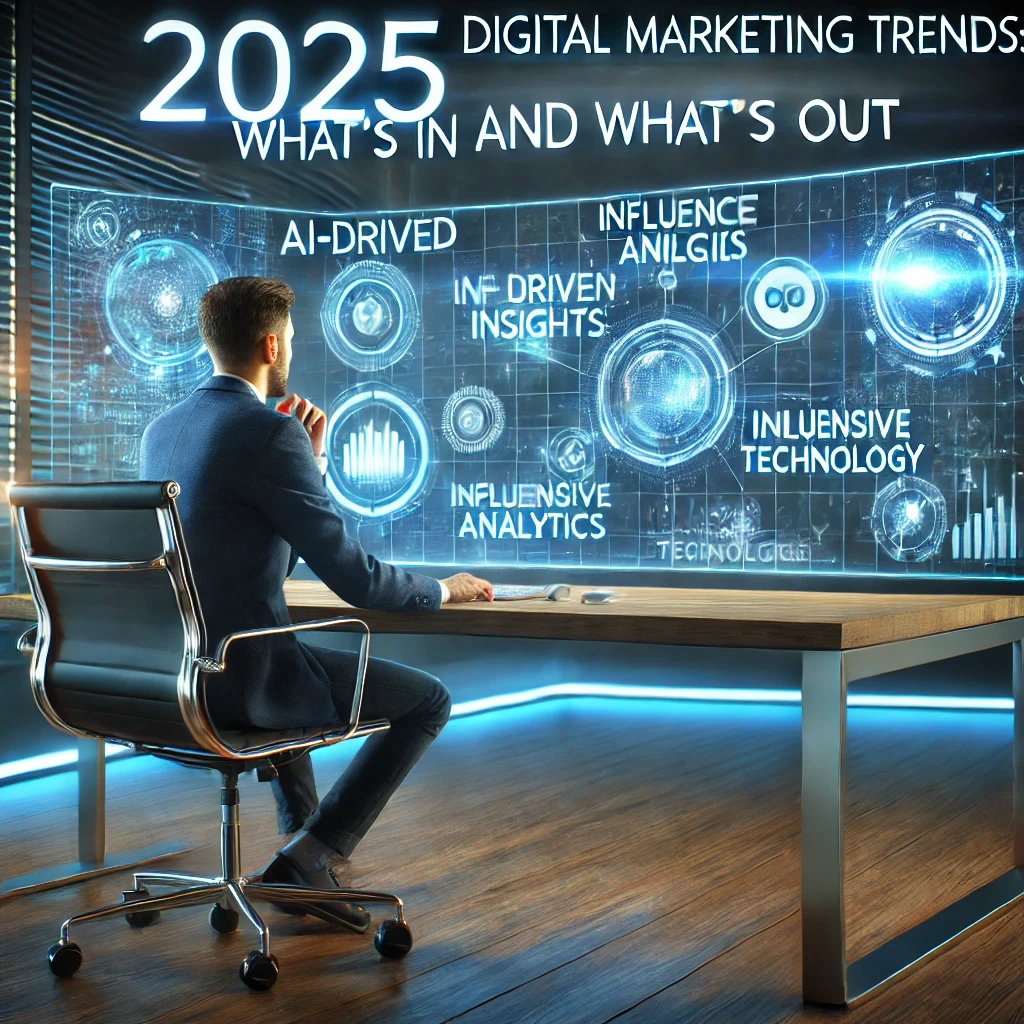2025 Digital Marketing Trends: What's In and What's Out
With the ever-changing digital landscape, keeping pace with upcoming trends is imperative for companies seeking to stay ahead of the curve. In 2025, innovation, consumer behavior changes, and technological innovations will propel digital marketing. Here is a close-up look at what’s in and what’s out for digital marketing in 2025.

What's In
AI-Powered Marketing
Artificial intelligence (AI) is transforming digital marketing. Companies are using AI for content creation, chatbots, predictive analysis, and automated customer experiences. AI technologies assist brands in creating customized experiences for their audience, improving engagement and conversion.
Artificial intelligence-driven tools like ChatGPT, Jasper, and Bard are transforming the way content is created, enabling marketers to produce highly personalized and engaging content. Predictive analytics is also a major benefit, enabling companies to study the behavior of consumers and predict their needs. AI-based customer support in the form of chatbots and virtual assistants is also gaining traction, enhancing response time and customer satisfaction.
Short-Form Video Content
As platforms such as TikTok, Instagram Reels, and YouTube Shorts continue to dominate, short videos are a marketing priority. Brands are prioritizing storytelling in seconds in order to grab attention and create engagement.
The success of short-form videos is based on creativity, authenticity, and interaction. Companies have to produce content that speaks to their target audience through humor, storytelling, or interactive features. Furthermore, live streaming is on the rise, enabling real-time engagement.
Voice Search Optimization
With increasingly integrated smart assistants such as Alexa, Siri, and Google Assistant, voice search optimization is more crucial than ever. Companies are adapting their SEO efforts to accommodate natural language-based searches and conversational search habits.
With voice search, long-tail keywords and question-based queries become crucial. Marketers also need to put emphasis on local SEO since most of the voice searches are location-based. Structured data and featured snippets are key to optimizing content for voice search.
Sustainable and Ethical Marketing
Customers are increasingly supporting brands that stand for sustainability, ethical sourcing, and corporate social responsibility. Values of transparency, authenticity, and environmental friendliness are influencing purchases, and so it is vital that brands mirror these values.
Green packaging, carbon-neutral products, and fair trade collaborations are becoming selling propositions. Brands practicing greenwashing and making false assertions about sustainable business practices risk damaging consumer trust. Ethical marketing goes beyond sustainability to include diversity, inclusion, and fair labor practices.
Interactive Content
Surveys, quizzes, live streams, and augmented reality (AR) experiences are going mainstream. Interactive content increases engagement and retains users actively engaging with a brand, resulting in more retention and loyalty.
Augmented reality shopping experiences, 360-degree video, and gamified content are on the rise. These content types enable users to interact with products prior to purchase, resulting in improved conversion rates and user satisfaction.
Influencer Marketing 2.0
Though influencer marketing is not new, it is changing. Micro and nano influencers, with highly engaged niche audiences, are more valuable than traditional celebrities. Authenticity and trust are the driving factors behind this change.
Brands are focusing on long-term collaborations with influencers instead of one-time sponsorships. This change ensures a more authentic connection with audiences and enables brands to establish credibility in their respective niches.
First-Party Data Collection
As privacy concerns escalate and third-party cookies are phased out, the focus is on gathering first-party data through personal interactions with the audience. Email subscriptions, loyalty rewards, and surveys are essential for upholding personalized marketing tactics.
First-party data is superior to third-party data, as it is received directly from the consumer. Brands have to invest in open data collection methods while giving value to the users in return for their details.
Personalized and Immersive Customer Experiences
Shoppers demand hyper-personalized experiences that suit their tastes. Companies are using AI, big data, and machine learning to study customer behavior and provide highly personalized experiences.
Augmented reality (AR) and virtual reality (VR) are transforming digital marketing into immersive experiences. Brands are employing AR-enabled try-on functionality for beauty and fashion goods, while VR is being used for virtual showrooms and interactive brand experiences.
Blockchain for Digital Marketing
Blockchain technology is finding its way into digital marketing because of its ability to offer transparency and security. Advertisers are using blockchain to fight ad fraud, authenticate impressions, and provide equitable transactions between brands and consumers.
Using blockchain, companies can establish trust among consumers, particularly in sectors where data security and authenticity are most essential. Blockchain also improves influencer marketing as it authenticates the validity of engagement figures.
What's Out
Legacy Third-Party Cookies
With major browsers eliminating third-party cookies, marketers can no longer rely on them for tracking user behavior. Companies must pivot to first-party data collection and contextual advertising.
This shift means businesses must create strong direct relationships with their audiences, leveraging AI and machine learning to analyze user behavior without violating privacy regulations.
Long, Unengaging Content
Customers are shifting away from long, text-based content. Rather, they want short, interactive, and visually stimulating information that can be quickly consumed, like short videos, infographics, and interactive content.
Blog posts and articles are still useful, but they need to be optimized for readability with bullet points, visuals, and easy takeaways. Companies should also convert long-form content into other formats to drive maximum engagement.
Generic Email Marketing
Mass, non-personalized email campaigns are on the decline. Instead, segmented and hyper-personalized email marketing with AI-based recommendations is gaining traction.
Email marketing automation software enables brands to send behavior-driven emails so that users see the right messages at the right time. Personalization goes beyond the use of a recipient’s name—it is about customized product suggestions, customized offers, and dynamic content.
Over-Reliance on Organic Social Media Reach
Social media sites keep changing their algorithms, which increases the difficulty in reaching organically. Companies have to integrate paid social ads and influencer collaboration to stay seen.
The best approach is one of balance between organic posts and targeted paid advertisements. Brands need to delve into new platforms and niche communities as well where they can reach with greater engagement.
One-Size-Fits-All Marketing Strategies
A one-size-fits-all marketing strategy is no longer viable. Personalization and customer obsession are key to success, as brands turn their attention to user behavior data and AI-powered insights to personalize campaigns.
Segmentation and audience analytics enable brands to create hyper-segmented campaigns. Marketers need to continually test and adjust their strategies in line with evolving consumer tastes.
Overlooking Mobile-First Strategies
Mobile-first marketing is no longer optional. Websites and digital content must be optimized for mobile users, as the majority of consumers consume content through smartphones and tablets.
Quick-loading websites, responsive design, and mobile-friendly content formats are essential. Brands should also utilize mobile payment mechanisms and SMS marketing as part of an extensive mobile strategy.
Final Thoughts
Being ahead in digital marketing requires flexibility and an openness to change. As AI, interactive content, and ethical marketing rise to the forefront, companies must re strategize in order to meet changing consumer demands. By emphasizing personalization, innovation, and genuine engagement, brands can become successful in 2025 and beyond.
Integrating these trends in your digital marketing campaign will keep your brand updated with the latest advancements in a fast-evolving online world. Do you want to be prepared for the future of digital marketing? Begin transforming into these shifts right now and leave your competition behind.
